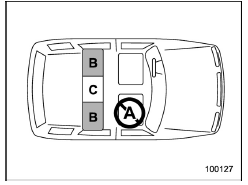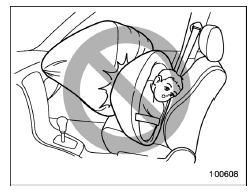Subaru Crosstrek Owners Manual: Where to place a child restraint system
The following are SUBARU's recommendations on where to place a child restraint system in your vehicle.

A: Front passenger's seat
You should not install a child restraint system (including a booster seat) due to the hazard to children posed by the passenger's airbag.
B: Rear seat, window-side seating positions
Recommended positions for all types of child restraint systems.
In these positions, the following equipment is provided for installing a child restraint system.
- Automatic Locking Retractor/Emergency Locking Retractor (ALR/ELR) seatbelts
- Lower anchorages (bars)
- Upper anchorages (tether anchorages)
Some types of child restraints might not be able to be secured firmly due to projection of the seat cushion.
In this seating position, you should use only a child restraint system that has a bottom base that fits snugly against the contours of the seat cushion and can be securely retained using the seatbelt.
C: Rear seat, center seating position
The ALR/ELR seatbelt and an upper anchorage (tether anchorage) are provided in this position.
Some types of child restraints might not be able to be secured firmly due to projection of the seat cushion.
In this seating position, you should use only a child restraint system that has a bottom base that fits snugly against the contours of the seat cushion and can be securely retained using the seatbelt.
When you install a child restraint system in the rear seat's center seating position, raise the center head restraint.
Lower anchorages (bars) for window-side seating positions may be used for a seat in the center seating position if a child restraint system manufacturer's instructions permit and specify using anchors as far apart as those in this vehicle.
If a child restraint system is not correctly fixed in place (for example, if a child restraint system can be moved more than 1 inch (2.5 cm) from side to side), you should install the child restraint system in a rear seat, window-side seating position.
WARNING
- Even with advanced airbags, children
can be seriously injured by
the airbag. Place children in the
rear seat properly restrained at
all times. The SRS airbag deploys
with considerable speed
and force and can injure or even
kill children, especially if they are
not restrained or improperly restrained.
Because children are lighter and weaker than adults, their risk of being injured from deployment is greater.
For that reason, be sure to secure ALL types of child restraint devices (including forward facing child seats) in the REAR seats at all times. You should choose a restraint device which is appropriate for the child's age, height and weight. According to accident statistics, children are safer when properly restrained in the rear seating positions than in the front seating positions.
- Do not use lower anchorages (bars) for a seat in the center seating position unless a child restraint system manufacturer's instructions permit and specify using anchors spaced as far apart as those in this vehicle.
- Do not connect two or more lower hooks onto the same anchorage (bar).

WARNING
SINCE YOUR VEHICLE I S EQUIPPED WITH A PASSENGER'S SRS AIRBAG, NEVER INSTALL A FORWARD OR REARWARD FACING CHILD SAFETY SEAT IN THE FRONT PASSENGER'S SEAT.
DOING SO RISKS SERIOUS INJURY OR DEATH TO THE CHILD BY PLACING THE CHILD'S HEAD TOO CLOSE TO THE SRS AIRBAG.
 Child restraint systems
Child restraint systems
Infants and small children should always
be placed in an infant or child restraint
system in the rear seat while riding in the
vehicle. You should use an infant or child
restraint system that ...
 Choosing a child restraint system
Choosing a child restraint system
Choose a child restraint system that is
appropriate for the child's age and size
(weight and height) in order to provide the
child with proper protection. The child
restraint system should mee ...
Other materials:
Dtc p2747 intermediate shaft speed sensor "b" circuit no signal
CONTINUOUSLY VARIABLE TRANSMISSION (DIAGNOSTICS) > Diagnostic Procedure with Diagnostic Trouble Code (DTC)DTC P2747 INTERMEDIATE SHAFT SPEED SENSOR "B" CIRCUIT NO SIGNALDTC detecting condition:Immediately at fault recognitionTrouble symptom:• Standing start problems• Shock o ...
Dtc p0354 ignition coil "d" primary control circuit/open
ENGINE (DIAGNOSTICS)(H4DO) > Diagnostic Procedure with Diagnostic Trouble Code (DTC)DTC P0354 IGNITION COIL "D" PRIMARY CONTROL CIRCUIT/OPENNOTE:For the diagnostic procedure, refer to DTC P0351. Diagnostic Procedure with Diagnostic Trouble Code (DTC) > DTC P0351 IGNITION COIL " ...
Dtc c2532 control module peripheral circuit
POWER ASSISTED SYSTEM (POWER STEERING) (DIAGNOSTICS) > Diagnostic Procedure with Diagnostic Trouble Code (DTC)DTC C2532 CONTROL MODULE PERIPHERAL CIRCUITTROUBLE SYMPTOM:• The steering wheel operation feels heavy.• STEERING warning light illuminates.WIRING DIAGRAM:Electric power steeri ...
